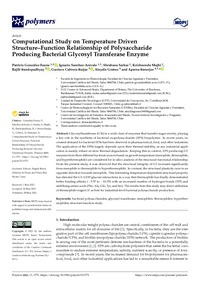Mostrar el registro sencillo de la publicación
Computational study on temperature driven structure–function relationship of polysaccharide producing bacterial lycosyl transferase enzyme
| dc.contributor.author | González-Faune, Patricio | |
| dc.contributor.author | Sánchez-Arévalo, Ignacio | |
| dc.contributor.author | Sarkar, Shrabana | |
| dc.contributor.author | Majhi, Krishnendu | |
| dc.contributor.author | Bandopadhyay, Rajib | |
| dc.contributor.author | Cabrera-Barjas, Gustavo | |
| dc.contributor.author | Gómez, Aleydis | |
| dc.contributor.author | Banerjee, Aparna | |
| dc.date.accessioned | 2021-12-30T14:59:07Z | |
| dc.date.available | 2021-12-30T14:59:07Z | |
| dc.date.issued | 2021 | |
| dc.identifier.uri | http://repositorio.ucm.cl/handle/ucm/3692 | |
| dc.description.abstract | Glycosyltransferase (GTs) is a wide class of enzymes that transfer sugar moiety, playing a key role in the synthesis of bacterial exopolysaccharide (EPS) biopolymer. In recent years, increased demand for bacterial EPSs has been observed in pharmaceutical, food, and other industries. The application of the EPSs largely depends upon their thermal stability, as any industrial application is mainly reliant on slow thermal degradation. Keeping this in context, EPS producing GT enzymes from three different bacterial sources based on growth temperature (mesophile, thermophile, and hyperthermophile) are considered for in silico analysis of the structural–functional relationship. From the present study, it was observed that the structural integrity of GT increases significantly from mesophile to thermophile to hyperthermophile. In contrast, the structural plasticity runs in an opposite direction towards mesophile. This interesting temperature-dependent structural property has directed the GT–UDP-glucose interactions in a way that thermophile has finally demonstrated better binding affinity (−5.57 to −10.70) with an increased number of hydrogen bonds (355) and stabilizing amino acids (Phe, Ala, Glu, Tyr, and Ser). The results from this study may direct utilization of thermophile-origin GT as best for industrial-level bacterial polysaccharide production. | es_CL |
| dc.language.iso | en | es_CL |
| dc.rights | Atribución-NoComercial-SinDerivadas 3.0 Chile | * |
| dc.rights.uri | http://creativecommons.org/licenses/by-nc-nd/3.0/cl/ | * |
| dc.source | Polymers, 13(11), 1771 | es_CL |
| dc.subject | Bacterial polysaccharides | es_CL |
| dc.subject | Glycosyl transferase | es_CL |
| dc.subject | Mesophiles | es_CL |
| dc.subject | Thermophiles | es_CL |
| dc.subject | Hyperthermophiles | es_CL |
| dc.subject | Structure function study | es_CL |
| dc.title | Computational study on temperature driven structure–function relationship of polysaccharide producing bacterial lycosyl transferase enzyme | es_CL |
| dc.type | Article | es_CL |
| dc.ucm.indexacion | Scopus | es_CL |
| dc.ucm.indexacion | Isi | es_CL |
| dc.ucm.uri | www.mdpi.com/2073-4360/13/11/1771 | es_CL |
| dc.ucm.doi | doi.org/10.3390/polym13111771 | es_CL |



